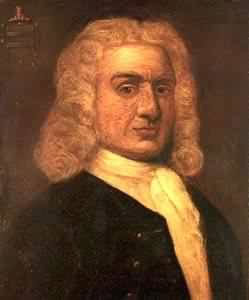The Wreck of the Quedagh Merchant
Since Captain William Kidd first reported the location of his abandoned vessel the Quedagh Merchant in 1699 until today, people have searched for the lost ship. While Kidd was locked in solitary confinement in England, Lord Bellomont sent Captain Nathaniel Cary to Hispaniola, who searched in vain for the ship. Legend of Kidd’s buried treasure also led many to attempt to find his documented spoils. Even today, modern treasure hunters searched in the Dominican Republic for the lost treasure vessel. However, in 2007 a snorkeler found a conglomerate of cannons and contacted the Dominican Republic’s Oficina Nacional de Patrimonio Cultural Subacuático (ONPCS), who then contacted Indiana University. A team of Indiana University archaeologists are now excavating and researching the shipwreck near Catalina Island off the southern coast of the Dominican Republic and have found that the archaeological record matches very well with the historical record, indicating that Captain Kidd’s lost ship, the Quedagh Merchant, has been found after more than 300 years.
The shipwreck of the Quedagh Merchant is characterized by a lack of upper hull structure and many of the ship’s components are not within the assemblage. However, much of the heavy cargo in the hold and some of the hull structure are firmly embedded in the seafloor. The shipwreck consists of 26 cannons, three large anchor crowns underneath a two-meter high pile of cannons, with a large encrusted magnetic anomaly seaward of the pile. The majority of the cannons are arranged as cargo in the hold, alternately stacked muzzle to cascabel. There are two distinct piles of cannons, with several disarticulated cannons between the piles. Under the main two-meter high pile we believe there are additional cannons and other scrap metal. The exposed anchor crowns and one fluke and other metallic anomalies identified with are indicative of the 10 tons of scrap iron, which Kidd testified was loaded onto the Quedagh Merchant at Madagascar (National Archives 5/860 fol. 197). Functional anchors would not be stored beneath the cannons, as they would need to be easily accessed in the event of a storm, and Kidd indicated he had 14-15 spare anchors and 10 tons of scrap iron (NA fol. 197). Additional anchors are anticipated to be documented within the pile as well as further iron conglomerate. Wooden hull remains were also discovered underneath the recovered cannon, possibly the keelson or keel of the vessel.
The wreck is situated in eight feet of water, only 25 meters from the rocky shoreline of the island, which explains how those that searched for the ship never found its remains. The site is in a high-energy zone with a large amount of wave action; any lighter artifacts were either carried out to sea or were washed into the rocky shoreline, along with the upper ship structure.



